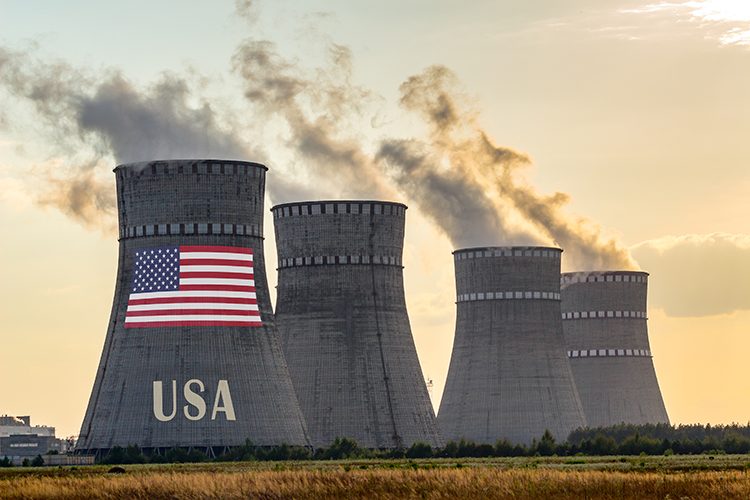The 30-Year Nuclear Wait
Plant Vogtle Unit Three is the first nuclear power site to be built under the post-1975 umbrella of the Nuclear Regulatory Commission.

This summer, people all over the world are flooding the theaters to see the movie “Oppenheimer.” The story is based on the life of J. Robert Oppenheimer, former director of the nuclear program at the Los Alamos National Laboratory.
In a sense, the movie is an outlier among the traditional July superhero blockbusters. It doesn’t feature comic book superheroes or creatures from outer space, but it does tap into another cultural obsession: nuclear energy. What is the status of nuclear power in the United States?
In the summer of 2023, a power plant called Plant Vogtle Unit Three became the first new nuclear site in 30 years. It was the first nuclear power plant constructed under the post-1975 umbrella of the Nuclear Regulatory Commission. A few other nuclear plants have added capacity or finished construction in the last 30 years, but their original paperwork was started prior to 1975. The site, located south of Augusta, Ga., plans to add a second reactor.
“This (100 percent capacity) milestone marks the maximum energy the unit is licensed to produce in the reactor core and is the first time the unit has reached its expected output of approximately 1,100 electric MW, which can power an estimated 500,000 homes and businesses,” notes Georgia Power (https://bit.ly/3qvYQCy). Plant Vogtle Unit Three could supply 19 percent of Georgia’s residents with electricity. Scheduled to be in service for 60 to 80 years, the plant is a win for the pro-nuclear crowd.
Nuclear Power: Decarbonization and Electric Grid Capacity
In the current political climate, there is motivation for nuclear to rejoin the energy team for a variety of reasons. Decarbonization is a major motivator for many. Nuclear could help reduce reliance on fossil fuels and provide steady power when the sun isn’t out and the wind isn’t blowing. Fission requires water to cool the reactors, but the daily output only evaporates water, not carbon dioxide.
Spent fuel rods are radioactive, but the plants don’t consume the same volume of raw materials compared to coal or natural gas power.
If decarbonization isn’t a motivating factor, building a stronger grid with American resources might be. Nuclear energy has national sources. Currently, Texas, Colorado, Nebraska, Utah and Wyoming are mining uranium. New Mexico is pulling uranium from the ground through a process called in situ leaching. Unlike a traditional mine, in situ leaching involves pumping a solution underground to dissolve the minerals and pumping them back to the surface (https://bit.ly/45gydjW).
If new power plants come online, nuclear energy could unite the political left and right by providing a modern, safe and consistent source of decarbonized American power. Can nuclear power overcome the bad memories associated with its past?
PBS breaks down the history of U.S. nuclear power with a timeline starting in 1958 (https://to.pbs.org/3qvZcsS). If this was the flashback montage in a superhero movie, the timeline would show the hero down on his luck. The images could leave you thinking, “I don’t know if they can come back from that …”
Three Mile Island, Chernobyl and Fukushima were some of the darkest moments in nuclear power plant history. Not to overlook the bombings of Hiroshima and Nagasaki, but they were intentional acts, not unintended power plant disasters.
Solar vs. Nuclear
Aside from the fear plotline, nuclear skeptics point to solar as a less expensive, faster-to-scale power plant technology. The Costco near my house sells solar PV panels, which is an anecdotal example of how quickly this technology has spread into the market while dropping in price.
Compare that to Plant Vogtle Unit Three, which came online at $24 billion over the original budget of $14 billion (https://bit.ly/3DOD3cu). These are not apples-to-apples comparisons, but the market shows a clear preference for solar in terms of capacity added.
As of 2019, renewable energy surpassed nuclear for annual electricity generation in terawatt-hours (https://bit.ly/3QwMJ2S). From 2012 to 2022, renewables went from 12 percent to 23 percent of the electricity generated in the United States (see Figure 1). In the future, 68 percent of the generation capacity planned to come online in 2024 will be rooftop or utility-scale solar.
Does nuclear energy have the potential for a comeback story? Nuclear capacity has been relatively flat since 1987, but there will be nuclear capacity additions in 2023 and 2024 with Vogtle Unit Three and Four. The Nuclear Regulatory Commission presents a more than five-year-long paperwork process, so the wheels turn slowly.
The red tape and procedure can change with demand. In 1974, responding to the OPEC oil embargo, President Gerald Ford did away with the Atomic Energy Commission. He shifted oversight to the Energy Research and Development Administration and the Nuclear Regulatory Commission to help alleviate the energy crisis.
The Energy Information Administration extrapolates planned power plant capacity in its “Annual Energy Outlook 2022.” While there will be a bump in new nuclear electricity generation in the short term, “capacity retirements and derating of some reactors will result in less total nuclear electricity generation capacity in 2050 than in 2021,” the report notes. This trajectory doesn’t project a comeback, but that could change (https://bit.ly/3Qy67N6).
Will the movie “Oppenheimer” help or hurt the nuclear power plant cause? The portrayal is bombastic and powerful, but will danger always be the defining sentiment of nuclear energy? Is it underused and tangled in the red tape of bureaucracy when we need it most? Is it potentially something in between a hero and a villain?
The addition of Plant Vogtle Unit Three in Georgia could be the moment when the hero gets on his feet and starts to fight back. Or, it could be a “too little, too late” moment in nuclear history. Billions over budget and years behind schedule can lead a movie studio to scratch a sequel; will the same thing happen to U.S. nuclear power plants?





